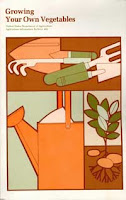Agriculture Information Bulletin 409
by the US Dept of Agriculture
When there\’s a change of seasons I get an itch to read gardening books. This slender volume is pretty packed with information. Growing Your Own Vegetables is a handbook containing articles by various professors of agriculture and other related fields, from different universities. Each short section is about a particular group of related plants: cucurbits, tomatoes and peppers, leafy salad vegetables, root crops, legumes, the onion family, herbs, etc. It gives advice on how to grow, care for and propagate the plants, recommends varieties and notes common problems that may be encountered (although not much on how to solve them beyond applying pesticides). The lists of plant diseases and pests dismayed me, but I found enough useful info to fill several pages of notes, and encouragement to try a few new plants in my garden next year. The book is a bit old- just over thirty years- but a lot of the information seems pertinent, and many of the vegetable varieties listed I recognized right away- Sweet 100 tomatoes, Detroit Dark Red beets, Longstanding Bloomsdale spinach, Fordhook Giant swiss chard- I guess the good ones stay around! I especially appreciated the chapter on asparagus and rhubarb- two perennial plants I want to establish in my own garden- and the one on uncommon vegetables, some I\’ve never heard of (dasheen, chayote, sunchoke) and others I\’d like to try growing when I\’m feeling braver and a bit more experienced (peanuts, artichoke, soybeans).
One interesting thing about the book is that although its contents have over a dozen authors, the voice is very consistent. Only one seemed to break with straightforward informative writing and throw in a bit of friendly humor, which made it stand out. The chapter on herbs has a general recipe for making butter, vinager or jelly with various herbs. Throughout the book are several charts on plant spacing and how many feet of each type will feed a family of four (or calculate by the number of adults in the household)- very useful.
I found this book at a discard sale. The copyright page tells me it contains Part 2 of the 1977 Yearbook of Agriculture. I\’m a bit curious what\’s in Part 1, but doubt I\’ll ever find out.
Rating: 3/5 244 pages, 1977











